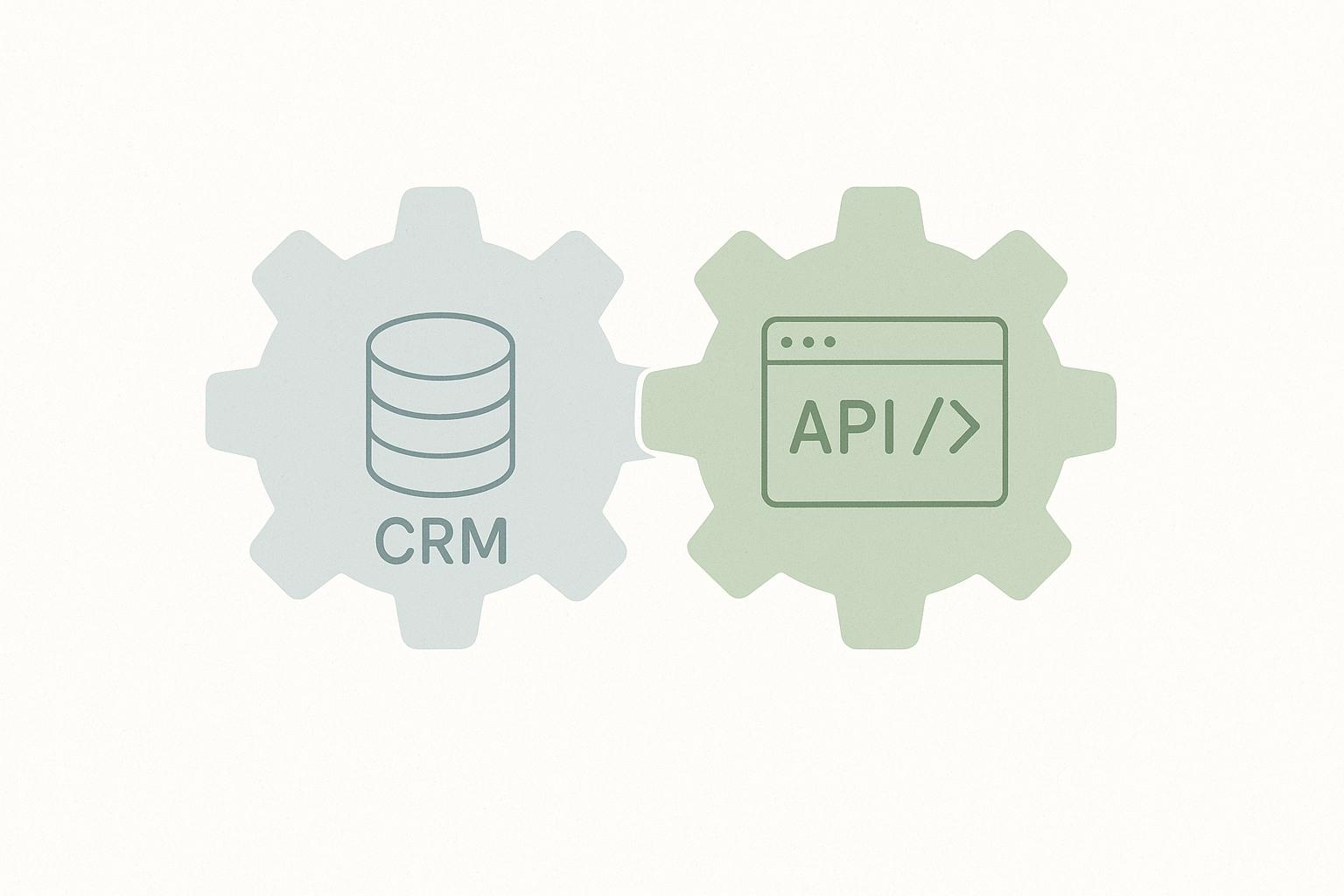Here’s the key: Spot trends, understand your customers, and use the right tools to act quickly. This guide breaks it down step-by-step:
-
Set Clear Goals
Define specific growth targets like revenue, customer acquisition, and market share. -
Track Metrics
Use data to measure progress: market growth, lead quality, and customer value. -
Study Market Trends
Watch consumer behavior, economic shifts, and competition for untapped opportunities. -
Segment Your Audience
Group customers by location, industry, or behavior for tailored strategies. -
Do Market Research
Combine surveys, competitor analysis, and sales data to refine your focus. -
Use Automation Tools
Platforms like CRMs and lead generation tools streamline finding and managing prospects. -
Evaluate Costs and Returns
Compare options by market size, competition, and financial potential.
Using Market Intelligence To Identify Potent Opportunities
Define Your Business Goals
Setting clear business goals helps you identify and focus on the right market opportunities. By defining your objectives, you can prioritize efforts and align them with your target markets.
Set Specific Growth Targets
Start by creating measurable goals that connect directly to your market opportunities:
- Revenue-focused: Define revenue targets for entering new markets.
- Time-bound: Set quarterly and yearly benchmarks.
- Market-specific: Tailor objectives for each market segment.
- Customer-centric: Outline goals for acquiring a specific number of new customers.
Automation tools can simplify tracking progress and managing leads. Platforms like Hatrio Sales offer CRM and lead generation features to streamline this process, helping you assess market potential and set achievable goals.
Once your targets are in place, use well-defined metrics to measure your progress.
Choose Success Metrics
Tracking the right metrics is key to evaluating how well you're progressing toward your goals. Focus on these key performance indicators:
| Metric Category | Key Metrics to Track |
|---|---|
| Market Growth | Market Share, Revenue Growth |
| Lead Quality | Lead Score, Conversion Rate |
| Cost Efficiency | Customer Acquisition Cost (CAC) |
| Customer Value | Customer Lifetime Value (CLV) |
Using tools like lead scoring, conversion rate analysis, and tracking metrics like CAC and CLV can help you gauge market potential. Automated CRM platforms, such as Hatrio Sales, make it easier to monitor these metrics and manage your leads effectively. This way, you can quickly identify which market opportunities are the best fit for your business objectives.
Study Market Data and Trends
Dive into consumer behavior and market trends to uncover new opportunities and refine your strategies.
Monitor Market Shifts
Keep an eye on market changes to stay ahead. Here's what to watch:
| Category | Key Metrics |
|---|---|
| Consumer Behavior | Buying patterns and browsing habits that reveal shifting preferences |
| Economic Indicators | Market size and growth rates that signal potential areas of focus |
| Technology Adoption | Digital activity and platform use that highlight effective channels |
| Competition | Market share and pricing strategies that expose gaps or opportunities |
Leverage automation tools to track these metrics in real-time. Tools like Hatrio Sales provide robust lead tracking and scoring features to help you stay informed.
Segment Markets Using Data
Data-driven segmentation allows you to identify customer groups that are often overlooked and understand their unique needs. Here's how to approach it:
-
Geographic Segmentation
Use location data to uncover regional opportunities. Platforms like Hatrio Sales can assist in identifying and enriching leads based on their geographic location. This information can be combined with professional and behavioral insights for a more targeted approach. -
Professional Demographics
Break down your audience by factors such as:- Company size
- Industry type
- Job roles
- Decision-making authority
-
Behavioral Patterns
Examine user activity through:- Website visits
- Content engagement
- Purchase history
- Preferred communication methods
Automated lead scoring tools can help prioritize these segments, ensuring your efforts are directed where they matter most. This segmentation strategy sets the stage for efficient lead management with advanced sales tools.
Do Market Research
Market research builds on earlier data insights by combining firsthand data collection with a close look at competitors.
Run Surveys and Study Competitors
| Research Method | Focus Areas | Insights Gained |
|---|---|---|
| Customer Surveys | Pain points, preferences | Unmet needs, feature requests |
| Usage Analytics | Behavioral patterns | Popular features, drop-off points |
| Competitor Analysis | Market positioning | Service gaps, opportunities |
| Sales Data | Purchase behaviors | Key customer segments |
Tools like Hatrio Sales can simplify data collection and analysis with features like lead scoring. These insights help you zero in on your ideal markets.
Define Target Markets
Use your research to focus on specific, promising customer groups:
-
Analyze High-Value Segments
Look at metrics like email response rates, engagement levels, purchase frequency, and customer lifetime value to identify your most valuable customers. -
Create Detailed Customer Profiles
Build profiles based on factors such as job roles, company size, industry, location, and behavioral trends. -
Validate Market Potential
Test your findings through email campaigns, analyze social proof, gather feedback from sales conversations, and assess lead scoring outcomes.
This process ensures you're targeting the right audience effectively.
sbb-itb-b22f30c
Use Sales Tools and Automation
Sales tools and automation can help uncover new opportunities while saving time and effort.
Automate Lead Generation
Streamline the process of finding and qualifying prospects across various markets. For instance, Hatrio Sales offers access to a massive database, featuring over 1.5 billion contacts, 100+ million global company profiles, and 50+ million local businesses.
| Lead Generation Feature | How It Helps Your Business |
|---|---|
| Email Discovery | Locate decision-makers based on location, title, or company size |
| Profile Enrichment | Add details like social profiles, company info, and website links |
| Lead Scoring | Automatically rank prospects by their engagement levels |
| Database Access | Focus on specific industries or regions effectively |
These tools can connect directly to your CRM, making the lead management process smoother.
Manage Leads with CRM Tools
Once leads are generated, a strong CRM system ensures they’re organized and nurtured. Key CRM capabilities include:
- Verifying lead information
- Running targeted marketing campaigns
- Monitoring engagement metrics
- Automating lead scoring processes
Use Customer Feedback for Better Insights
Sales tools don’t just handle leads - they also gather valuable feedback from customers. Advanced platforms often include features like:
- Sales Chatbots: Interact with website visitors and gather instant feedback
- Review Management: Keep track of customer opinions across multiple platforms
- Social Proof Monitoring: Observe how customers engage with your brand online
- Lead Activity Analysis: Spot trends in customer behavior to fine-tune your approach
Combining automated lead management with real-time customer insights can help you sharpen your overall strategy.
Rate and Pick Opportunities
Once you've completed your market research, it's time to narrow down and select the best opportunities. This step focuses on evaluating and prioritizing options to find the most promising ones.
Check Costs and Returns
Take a close look at the financial side of things. Assess the initial investment, ongoing expenses, potential revenue, and how long it will take to break even. Here's a breakdown:
| Financial Aspect | What to Measure | Why It Matters |
|---|---|---|
| Initial Investment | Equipment, training, software costs | Helps you plan resource allocation |
| Operating Costs | Monthly expenses, staff, marketing | Impacts long-term financial health |
| Expected Revenue | Projected sales, market share | Indicates growth potential |
| Break-even Timeline | Months to profitability | Aids in cash flow management |
Using tools like Hatrio Sales can simplify this process. For example, their lead scoring system evaluates prospect engagement and conversion likelihood, giving you a clearer picture of potential revenue.
Compare Options Side by Side
Lay out your options and compare them using specific criteria. Focus on these key areas:
| Evaluation Criteria | Key Questions to Answer |
|---|---|
| Market Size | What's the total addressable market value? |
| Growth Rate | How fast is the market expanding year over year? |
| Competition Level | How many established players are there? |
| Entry Barriers | What resources are needed to enter this market? |
| Customer Access | How easily can you reach your target audience? |
By analyzing these factors, you can identify opportunities that align well with your goals and resources.
Match Options to Resources
Make sure the opportunities you're considering fit your current capabilities. Take into account:
- Lead Generation Capacity: Can your tools handle capturing leads in this new market?
- Data Management: Is your CRM equipped to manage additional data volume?
- Team Expertise: Does your team have the skills needed, or will training be required?
It's smart to prioritize opportunities that play to your strengths. For example, if your systems already excel at collecting detailed customer data, target markets where customer insights can give you an edge. This approach ensures you're leveraging what you already do well while minimizing risks.
Conclusion: Steps to Market Growth
To achieve scalable market growth, it's crucial to combine thorough market research with efficient automation techniques. A structured, data-driven approach helps turn opportunities into tangible results.
Here’s a breakdown of the key phases in market growth and their outcomes:
| Growth Phase | Key Actions | Expected Outcomes |
|---|---|---|
| Discovery | Conduct market research and analyze trends | Identify target segments |
| Validation | Use customer surveys and analyze data | Confirm market demand |
| Execution | Implement lead generation and automation | Streamline the sales process |
| Scaling | Optimize CRM systems | Boost conversion rates |
Sales automation tools play a critical role in enhancing each phase. They help businesses simplify and improve their growth strategies by:
- Lead Generation: Identify and connect with prospects based on location, industry, or company size.
- Data Enrichment: Create detailed profiles of prospects to improve engagement.
- Automated Workflows: Scale outreach efforts while keeping communication personalized.
FAQs
How can automation tools help businesses discover new market opportunities?
Automation tools can greatly simplify the process of uncovering new market opportunities by optimizing key tasks. They can identify and enrich leads by analyzing factors like location, job title, and company size, while also gathering valuable information such as social profiles, company details, and website data.
Additionally, these tools streamline outreach efforts by automating tasks like drip campaigns, follow-ups, and social media engagement, saving businesses time and resources. With features like lead scoring, businesses can prioritize high-potential prospects, enabling them to focus on the most promising opportunities and drive growth efficiently.
What financial factors should businesses evaluate when exploring new market opportunities?
When assessing potential market opportunities, it’s crucial to analyze key financial aspects that impact growth and profitability. Start by considering lead generation strategies, which involve identifying and enriching high-quality leads based on factors like location, job title, and company size.
Additionally, ensure you have access to tools that provide detailed data enrichment, such as adding names, social profiles, and company insights to your leads. These capabilities not only streamline your sales workflows but also help you make informed decisions about entering new markets effectively.
How can customer segmentation help identify new market opportunities?
Customer segmentation allows businesses to divide their audience into smaller, more defined groups based on characteristics like demographics, behavior, or preferences. By analyzing these segments, companies can uncover underserved or overlooked groups, helping them identify untapped market opportunities.
For example, segmentation might reveal a specific age group or geographic area with unmet needs, enabling businesses to tailor products, services, or marketing strategies to better serve these customers. This targeted approach not only drives growth but also enhances customer satisfaction and loyalty.



